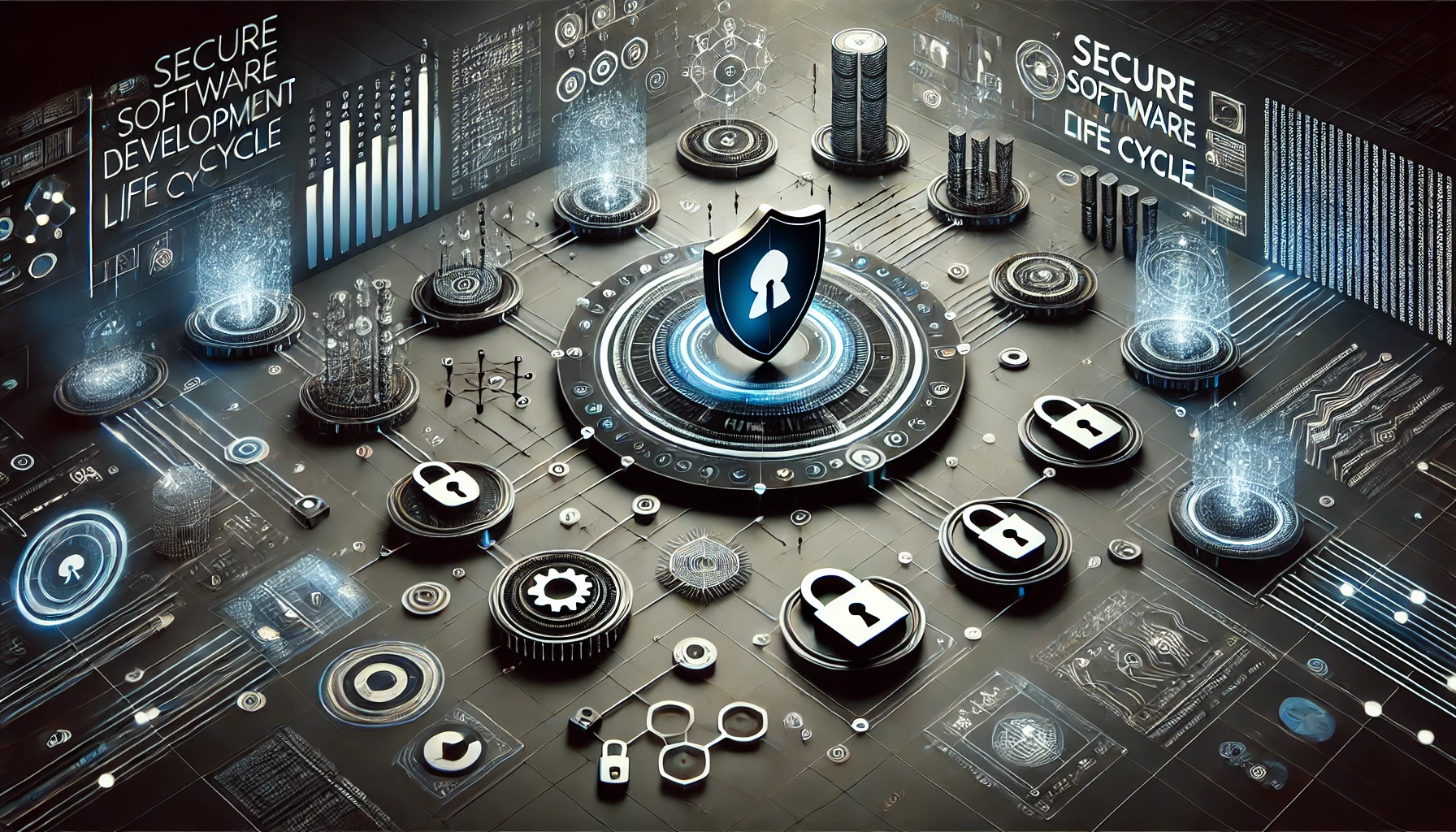
The Secure Software Development Life Cycle (SSDLC) is a comprehensive process that integrates security practices into every phase of software development. In an age where cyber threats are escalating in complexity and frequency, embedding security from the ground up is not just beneficial—it’s essential. This exhaustive guide explores SSDLC in detail, covering its principles, phases, methodologies, best practices, tools, compliance requirements, challenges, and real-world applications.
Introduction to SSDLC
In traditional software development, security has often been an afterthought—addressed only during the testing phase or, worse, after deployment when vulnerabilities are exploited. The Secure Software Development Life Cycle (SSDLC)revolutionizes this approach by embedding security considerations into every step of the development process.
SSDLC is not a one-size-fits-all model but a framework adaptable to various development methodologies, including Waterfall, Agile, and DevOps. It emphasizes proactive identification and mitigation of security risks, ensuring that software products are robust against cyber threats from inception to retirement.
The Evolution of Software Development and Security
- Early Computing Era: Security was minimal due to isolated systems.
- Internet Revolution: Connectivity introduced new attack vectors.
- Modern Development: Rapid development cycles and complex applications increased vulnerabilities.
- Emergence of SSDLC: Recognizing the need for integrated security in response to sophisticated cyber threats.
Why SSDLC is Crucial
- Increasing Cyber Threats: Cyberattacks are becoming more frequent and sophisticated.
- Regulatory Compliance: Laws mandate data protection and security practices.
- Cost Savings: Early detection of security flaws reduces remediation costs.
- Customer Trust: Secure applications enhance brand reputation and customer confidence.
- Competitive Advantage: Organizations with robust security practices stand out in the market.
Core Principles of SSDLC
- Security as a Continuous Process: Security is ongoing, not a one-time task.
- Risk Management: Prioritize security efforts based on risk assessments.
- Least Privilege: Users and systems operate with the minimum privileges necessary.
- Defense in Depth: Multiple layers of security controls.
- Secure Defaults: Systems are secure by default, requiring explicit changes to reduce security.
- Fail Securely: Systems handle failures without compromising security.
- Open Design: Security does not rely on secrecy of design or implementation.
Detailed Phases of the Secure Software Development Life Cycle
1. Requirement Gathering and Analysis
Objective: Collect and define functional and security requirements.
Key Activities:
- Stakeholder Interviews: Understand user needs and expectations.
- Security Requirements Elicitation: Identify confidentiality, integrity, and availability needs.
- Regulatory Requirements Identification: Determine compliance obligations.
- Security Risk Assessment: Analyze potential security risks at a high level.
Outputs:
- Requirements Specification Document
- Security Requirements Document
Best Practices:
- Use Security Checklists: Ensure all security aspects are considered.
- Define Clear Security Goals: Align security objectives with business goals.
2. Planning and Feasibility Study
Objective: Determine project viability, resource allocation, and define a security plan.
Key Activities:
- Feasibility Analysis: Assess technical, economic, legal, and operational feasibility.
- Security Planning: Develop a security plan outlining security tasks, responsibilities, and timelines.
- Budgeting: Allocate resources for security activities.
Outputs:
- Project Plan
- Security Plan
Best Practices:
- Involve Security Experts Early: Integrate security professionals in planning discussions.
- Establish Security Metrics: Define how security effectiveness will be measured.
3. Design and Architecture
Objective: Create a secure design that addresses functional and security requirements.
Key Activities:
- Architectural Design: Define system architecture with security considerations.
- Data Flow Diagrams (DFDs): Map data movements to identify potential vulnerabilities.
- Threat Modeling: Systematically identify threats using models like STRIDE or PASTA.
- Security Control Design: Specify security controls and mechanisms.
Outputs:
- Design Specification Document
- Threat Model Document
- Security Architecture Document
Best Practices:
- Apply Secure Design Patterns: Use proven patterns to address common security issues.
- Review Third-Party Components: Assess security of libraries and frameworks.
4. Development (Implementation)
Objective: Write secure code following best practices and standards.
Key Activities:
- Coding Standards Compliance: Adhere to secure coding guidelines (e.g., OWASP, CERT).
- Code Reviews and Inspections: Peer reviews focusing on security vulnerabilities.
- Static Code Analysis: Use SAST tools to detect code-level vulnerabilities.
- Dependency Management: Monitor and update third-party dependencies.
Outputs:
- Source Code
- Code Review Reports
- Static Analysis Reports
Best Practices:
- Implement Code Signing: Ensure code integrity and authenticity.
- Use Secure Coding Checklists: Standardize security checks during coding.
5. Testing and Verification
Objective: Validate that the software meets security requirements and is free from vulnerabilities.
Key Activities:
- Unit Testing: Test individual components for security flaws.
- Integration Testing: Verify security at integration points.
- System Testing: Assess the entire system’s security posture.
- Penetration Testing: Simulate attacks to find vulnerabilities.
- Dynamic Analysis: Use DAST tools to test running applications.
- Fuzz Testing: Input random data to find unexpected behaviors.
- Security Regression Testing: Ensure that new changes haven’t introduced vulnerabilities.
Outputs:
- Test Plans and Cases
- Test Reports
- Vulnerability Assessment Reports
Best Practices:
- Automate Testing: Integrate security tests into CI/CD pipelines.
- Use Test Data Appropriately: Avoid using real customer data in testing.
- Prioritize Vulnerabilities: Address high-risk issues first.
6. Deployment and Integration
Objective: Deploy the application securely into the production environment.
Key Activities:
- Final Security Review: Ensure all security requirements are met.
- Secure Configuration: Apply security hardening to servers and infrastructure.
- Environment Validation: Confirm that the deployment environment matches the tested environment.
- Documentation: Provide security-related documentation for operations teams.
Outputs:
- Deployed Application
- Deployment Guides
- Configuration Management Plans
Best Practices:
- Implement Secure Deployment Practices: Use secure protocols and authentication mechanisms.
- Encrypt Sensitive Data: Protect data at rest and in transit.
- Set Up Monitoring and Logging: Enable security event logging for incident detection.
7. Operations and Maintenance
Objective: Maintain and improve security throughout the software’s operational life.
Key Activities:
- Monitoring: Continuously monitor for security incidents.
- Patch Management: Apply security updates promptly.
- Incident Response: Have a plan to respond to security incidents.
- Periodic Security Assessments: Regularly reassess the application’s security posture.
- User Training and Awareness: Educate users on security best practices.
Outputs:
- Incident Reports
- Maintenance Logs
- Updated Documentation
Best Practices:
- Review Access Controls Regularly: Ensure that user permissions are appropriate.
- Backup and Recovery Plans: Maintain data integrity and availability.
- Continuous Improvement: Use feedback loops to enhance security practices.
Security Activities in Each Phase
- Requirement Phase: Security requirements definition, risk identification.
- Design Phase: Threat modeling, security architecture design.
- Development Phase: Secure coding practices, static code analysis.
- Testing Phase: Security testing, vulnerability scanning, penetration testing.
- Deployment Phase: Secure configuration, security reviews.
- Maintenance Phase: Monitoring, patch management, security audits.
Best Practices in Implementing SSDLC
Integrating Security into Agile and DevOps
- Security User Stories: Incorporate security requirements as user stories in Agile sprints.
- Continuous Integration and Continuous Deployment (CI/CD): Automate security tests within CI/CD pipelines.
- Security Champions: Assign team members to advocate for security in Agile teams.
Security Training and Awareness
- Developer Training: Regular workshops on secure coding and latest threats.
- Security Certifications: Encourage certifications like CISSP, CSSLP.
- Awareness Programs: Company-wide initiatives to promote a security culture.
Secure Coding Standards and Guidelines
- Establish Standards: Define coding standards specific to the organization.
- Code Review Checklists: Use standardized checklists during code reviews.
- Language-Specific Guidelines: Apply guidelines relevant to programming languages used.
Threat Modeling Techniques
- STRIDE Model: Focus on Spoofing, Tampering, Repudiation, Information Disclosure, Denial of Service, Elevation of Privilege.
- PASTA (Process for Attack Simulation and Threat Analysis): A seven-step process focusing on business objectives.
- Attack Trees: Visual representations of potential attack paths.
Risk Assessment and Management
- Risk Identification: Identify assets, threats, and vulnerabilities.
- Risk Analysis: Determine the likelihood and impact of risks.
- Risk Mitigation Strategies: Accept, avoid, transfer, or mitigate risks.
- Risk Monitoring: Continuously monitor and reassess risks.
Tools and Technologies Supporting SSDLC
Static Application Security Testing (SAST)
- Purpose: Analyze source code or binaries for vulnerabilities.
- Advantages: Early detection of security flaws.
- Examples:
- SonarQube
- Fortify Static Code Analyzer
- Checkmarx
- Veracode
Dynamic Application Security Testing (DAST)
- Purpose: Test running applications for vulnerabilities.
- Advantages: Identifies runtime issues like authentication problems, server configuration errors.
- Examples:
- OWASP ZAP
- Burp Suite
- Acunetix
- AppScan
Interactive Application Security Testing (IAST)
- Purpose: Combines SAST and DAST by analyzing applications during runtime with code-level insight.
- Advantages: Provides detailed vulnerability context.
- Examples:
- Contrast Security
- Seeker by Synopsys
- HCL AppScan
Runtime Application Self-Protection (RASP)
- Purpose: Protects applications in real-time by detecting and blocking attacks.
- Advantages: Immediate response to threats without human intervention.
- Examples:
- Imperva RASP
- Signal Sciences
- Veracode Runtime Protection
Software Composition Analysis (SCA)
- Purpose: Manages open-source components and licenses.
- Advantages: Identifies vulnerabilities in third-party libraries.
- Examples:
- Black Duck
- Snyk
- WhiteSource
Container Security Tools
- Purpose: Secure containerized applications.
- Advantages: Scans container images for vulnerabilities.
- Examples:
- Docker Security Scanning
- Clair
- Anchore Engine
Compliance and Regulatory Standards
GDPR
- Focus: Data protection and privacy for individuals within the EU.
- SSDLC Relevance: Requires data protection by design and default.
HIPAA
- Focus: Protecting sensitive patient health information.
- SSDLC Relevance: Mandates security measures for healthcare applications.
PCI DSS
- Focus: Security standards for handling credit card information.
- SSDLC Relevance: Requires secure development practices for payment applications.
ISO/IEC Standards
- ISO/IEC 27001: Information Security Management Systems.
- ISO/IEC 27034: Application Security.
- SSDLC Relevance: Provides frameworks for implementing and managing security.
NIST Guidelines
- NIST SP 800-64: Security Considerations in the System Development Life Cycle.
- SSDLC Relevance: Offers guidance on integrating security into SDLC.
Challenges and Solutions in Implementing SSDLC
Cultural and Organizational Resistance
Challenges:
- Resistance to change established workflows.
- Perception of security as a hindrance to productivity.
Solutions:
- Executive Support: Secure buy-in from top management.
- Communication: Highlight the benefits of SSDLC to all stakeholders.
- Security Champions: Identify advocates within teams.
Resource Allocation
Challenges:
- Limited budgets for security initiatives.
- Lack of skilled security professionals.
Solutions:
- Prioritize High-Risk Areas: Focus resources where they are most needed.
- Leverage Open-Source Tools: Utilize free tools where appropriate.
- Training Programs: Invest in upskilling existing staff.
Integration Complexity
Challenges:
- Difficulty integrating security tools with existing workflows.
- Tool compatibility issues.
Solutions:
- Choose Compatible Tools: Select tools that integrate well with current systems.
- Phased Implementation: Gradually introduce tools to minimize disruption.
- Automation: Use APIs and automation scripts to streamline integration.
Keeping Up with Emerging Threats
Challenges:
- Rapid evolution of cyber threats.
- Difficulty in updating security practices accordingly.
Solutions:
- Continuous Learning: Encourage ongoing education and training.
- Threat Intelligence: Subscribe to threat intelligence feeds.
- Community Involvement: Participate in security forums and conferences.
Real-World Case Studies
Case Study 1: Financial Institution Enhancing Security
Background:
A major bank recognized the need to improve its software security after minor incidents.
Actions Taken:
- Implemented SSDLC across all development teams.
- Integrated SAST and DAST tools into CI/CD pipelines.
- Conducted regular security training sessions.
Results:
- Reduced security vulnerabilities by 80%.
- Achieved compliance with regulatory standards.
- Enhanced customer trust and satisfaction.
Case Study 2: E-commerce Platform Security Breach
Background:
An e-commerce company suffered a data breach due to SQL injection attacks.
Issues Identified:
- Lack of input validation in code.
- No regular security testing.
Lessons Learned:
- Importance of secure coding practices.
- Need for regular security assessments.
Actions Taken:
- Adopted SSDLC practices.
- Provided secure coding training to developers.
- Implemented automated security testing tools.
Outcomes:
- No security breaches reported in the following years.
- Improved code quality and security awareness.
Future Trends in SSDLC
AI and Machine Learning in Security
- Predictive Analysis: AI can predict potential vulnerabilities.
- Automated Code Review: Machine learning models assist in detecting code flaws.
- Adaptive Security: Systems that learn and adapt to new threats.
Shift-Left Security
- Early Integration: Moving security considerations even earlier in the development process.
- Developer-Centric Tools: Tools designed for ease of use by developers.
Zero Trust Architecture
- Principle: Never trust, always verify.
- SSDLC Implication: Applications are designed with strict access controls and continuous verification.
Conclusion
The Secure Software Development Life Cycle is integral to producing robust, secure, and reliable software. By embedding security into every phase of development, organizations can proactively address vulnerabilities, comply with regulations, and protect their assets and customers. Implementing SSDLC requires commitment, resources, and cultural change, but the benefits far outweigh the challenges.
As the cybersecurity landscape evolves, so too must our approaches to security in software development. Embracing SSDLC is not just about mitigating risks—it’s about building a foundation for innovation and trust in the digital age.
Frequently Asked Questions (FAQs)
Q1: What is the main difference between SDLC and SSDLC?
A1: The main difference is that SSDLC integrates security practices into every phase of the SDLC, whereas traditional SDLC may treat security as a separate or later concern.
Q2: How can small organizations implement SSDLC with limited resources?
A2: Small organizations can prioritize high-risk areas, leverage open-source security tools, and focus on training developers in secure coding practices to implement SSDLC effectively.
Q3: Is SSDLC compatible with Agile methodologies?
A3: Yes, SSDLC can be integrated into Agile by incorporating security tasks into sprints, using security user stories, and automating security tests in the CI/CD pipeline.
Q4: What role does DevSecOps play in SSDLC?
A4: DevSecOps extends the DevOps model by integrating security practices throughout the development and operations lifecycle, aligning closely with SSDLC principles.
Q5: How often should security training be provided to development teams?
A5: Regularly—ideally, at least annually, with updates provided as new threats emerge or when significant changes occur in the development environment.
References and Further Reading
- OWASP Secure Software Development Life Cycle Project: OWASP SSDLC
- Microsoft Security Development Lifecycle: Microsoft SDL
- NIST SP 800-64 Revision 2: NIST Security Considerations
- ISO/IEC 27034-1:2011: Application Security
- The CERT Oracle Secure Coding Standard for Java: Secure Coding Standards
- DevSecOps: A Leader’s Guide to Producing Secure Software Without Slowing Down: DevSecOps Guide
Stay Connected with Secure Debug
Need expert advice or support from Secure Debug’s cybersecurity consulting and services? We’re here to help. For inquiries, assistance, or to learn more about our offerings, please visit our Contact Us page. Your security is our priority.
Join our professional network on LinkedIn to stay updated with the latest news, insights, and updates from Secure Debug. Follow us here







